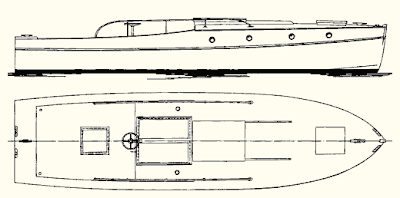This posting features Gracie III by Capt. R.D. "Pete" Culler. She was originally designed for use as a yard tug at The Concordia Company, Padanaram, MA. Tough service day in and day out necessitates a heavily built boat. Capt. Pete wrote some great commentary on the development of her design. I first saw her study plans in "Skiffs and Schooners," a collection of designs, commentaries, and previously published articles by the designer. She also appears in "Pete Culler On Wooden Boats," and "Pete Culler's Boats." Her plans are available from Mystic Seaport Museum, which now houses all of his design work.
There might be enough data to build her as published in Skiffs and Schooners, but I'd recommend getting the plans. There's a lot going on in this little girl. The captions for the construction photos refer to "the 12' 6" towboat Gracie III." These are typos. She is 15' and change overall. Perhaps they refer to waterline length, but I'm not sure why they would do that for a workboat. It's not like she needs a more favorable PHRF rating...
At any rate, she's a simple and stout boat. Built to take a pounding, turn on a dime, and go where you send her. A tug of any size is basically a box with enough volume to float a large engine and enough depth to sink a big, slow-turning prop. The art comes in making one as sightly and useful as this, especially in such a tidy package.

I don't think there's a better way to build her than exactly as designed: a MASSIVE solid backbone, sawn frames with substantial gusseting, and traditional planking of solid wood. Planking below the chine is shown "Chesapeake style," that is laid on an angle from the centerline out to the chine. This results in short pieces up in the forefoot that follow the substantial twist there. Much easier than trying to persuade thick stock to take that shape. Above the chine she is planked in the traditional carvel manner, except around that beautiful stern where she is "staved" vertically. The stern isn't just for looks; hard corners at the transom will hook a tow line and flip a boat in a heart beat.


That big towing bitt braced with massive knees is situated exactly over her pivot point. I like the monkey-stick steering, too. (Note that of the actual boats in my possession, Strider has [is getting] wheel steering, Dark Secret has a Norwegian push/pull tiller, and the Thistle has a traditional tiller. That would make four steering methods for four boats)
There are precious few designs out there on which I wouldn't tweak a little something here, or make a little change there. Gracie III should be built exactly as drawn. The only modification I would consider is the "table" around the tow bitt. I'd extend it forward a couple of inches so it can be bored to hold up a tiki-hut style umbrella. What better way to enjoy a calm cay on the river? Some shade, some diesel fumes, a book, and a wee taste of the amber...
I'd put up more photos, but If you like what you see, you should get the book(s). They are worth owning.
Edit 5/14/14:
While going through some old paperwork I found the beginnings of a proposal I wrote 6 or 8 years ago (maybe more). When I start dreaming, I don't do it half-assed.
The intent was to develop and implement a program for at-risk students from a few different area school districts to build Gracie III as designed, but with a hydrogen fuel cell drive line. A west coast company that builds fuel cells for fork trucks and other industrial applications was willing to make available an appropriately sized "stack" (15-18 kw?) and engineering support to help make it happen. An automotive supercharger to deliver the required air charge, a heat exchanger (their fork trucks are liquid to air, ours would be liquid to liquid), a small network of sensors, a motor, and some other giblets would be needed. The only support they could not offer was their proprietary computer code for the sensor/control/user interface systems. We would have been on our own for that. Projected range was about 6 hours run time on a tank of the size that you'd see in a welding shop. The weight of the stack, motor, battery bank, tank, and the rest of the guts is closely comparable to the diesel drive line, roughly 800 lbs. in either case.
What a great project it could be - Aside from getting to build a wicked salty little tub, the real coup would be the development of a scalable and reliable marine propulsion system using this existing technology. If successful, the potential revenue from that system could make the program a long-term self-funding operation. Traditional woodworking, electrical/mechanical engineering, cutting-edge technology, code writing, high-level troubleshooting/problem solving - what more could an under-achieving student want? Optimally, participation in the program would count as a full year of high school.
The project itself is not the expensive part. The boat and drive line parts are "only" about $35-45k. Curriculum development, work/classroom space, salaries for at least two, if not three instructors, administration, liability insurance, shop tools, computers, and all of the other stuff that never even made the list started adding up to a truly daunting number. I was eventually discouraged by nay-sayers, not the quietest of whom was myself...
Shoulda, coulda, woulda...



